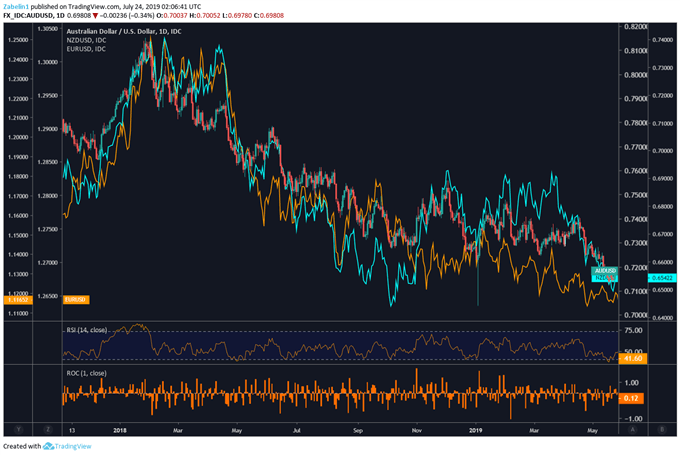IMF WORLD ECONOMIC OUTLOOK, LEVERAGED DEBT MARKET, US DOLLAR, TRADE WARS – TALKING POINTS
- IMF World Economic Outlook publication for July points to slower growth and trade war risks
- Increased borrowing costs, exposed emerging markets, expanding debt market sounding alarm
- Downside risks caused rise in Fed rate cut bets – USD shrugged, capitalized on sour appetite
See our free guide to learn how to use economic news in your trading strategy !
At the end of Tuesday’s trading session – as expected – the US Dollar emerged triumphant after the IMF published its updated world economic outlook and spooked financial markets . Global GDP forecasts for 2019 and 2020 were once again downgraded to now showing an expected growth rate of 3.2 percent and 3.5 percent, respectively. In the report, five fundamental themes stood out as the primary culprits behind the slowdown.
Fundamentals First

TRADE WARS
Predictably, trade tensions were highlighted as one of the primary factors hampering global growth. The US-China and EU-UK trade disputes continue to sap business confidence have subsequently created headwinds for investment and significantly contributed to the overall deceleration in economic activity. The report made it a point for countries to “not use tariffs to target bilateral trade balances or as a substitute for dialogue”
AUDUSD, EURUSD, NZDUSD Downtrend Amplified by Trade War

Furthermore, the prospective disruption of technology supply chains – largely in Asia – has also stifled investment and contributed to the regional slowdown. Sino-US tensions continue to remain high in light of the ongoing controversy surrounding Huawei that is compounded by the growing fear that China may leverage a ban on rare-mineral exports to the US if trade negotiations deteriorate.
GEOPOLITICAL RISKS
As the global economy slows down, the market impact of geopolitical risks is amplified because the buffer of economic prosperity that is typically used to stave off ideological radicalism has been eroded. “Prolonged” Brexit negotiations have sapped sentiment and led to capital outflow from European markets and led to the central banks in the UK and Sweden to alter their monetary policy trajectory as a result of the uncertainty.
Crude Oil Prices Rise on Supply-Disruption Fears

The report cited an escalation in geopolitical tensions – notably in the Persian Gulf – as a contributing factor to uncertainty and a major driver behind volatility in crude oil prices. EU-US ties continue to be strained by trade tensions and divergence in policy towards Iran. Furthermore, political contagion from the developed economies is now spreading to emerging markets and further souring risk appetite.
EMERGING MARKET RISKS
Emerging market (EM) trade tensions – e.g. Brazil-India, Brazil-Iran, India-Pakistan, India-US etc – are stressing frontier economies that are already under duress from slowing global demand. Economic activity in commodity-linked countries has been disappointing and are also the most vulnerable to oscillations in global sentiment.
Core inflation has remained broadly subdued in emerging market economies in large part due to souring sentiment from trade tensions and capital outflow. Furthermore, EMs were dealt another blow after the publication of China GDP showed a year-on-year growth rate of 6.2 percent, the slowest expansion in almost three decades.
BORROWING COSTS
In addition to unwinding the balance sheet, the Fed’s rate hike rampage in 2018 significantly tightened borrowing costs around the world. According to the Bank of International Settlements, over 80 percent of all global transactions are conducted in the US Dollar. For emerging markets that have their debt denominated in the US Dollar, this has meant higher debt-servicing costs in real terms, adding to overall fragility in global financial markets.
An economic slowdown may stoke uncertainty about such countries' ability to meet their obligations, especially since many emerging market economies rely on exporting cycle-sensitive commodities. As any serious de-risking probes the global financial system, vulnerabilities are likely to be exposed. EM CDS spreads will probably widen against this backdrop, leaving financial institutions with exposure to these markets at risk.
DEBT RISKS
In the report, the IMF writes “A risk-off episode, depending on its severity, could expose financial vulnerabilities accumulated during years of low interest rates as highly leveraged borrowers find it difficult to roll over their debt”. Some Insitutions have also been securitizing loans with poor underwriting standards into collateralized loan obligations that threaten to create a $1 trillion crater in the financial system.
Tick, Tick, Tick…

The report also highlighted that after a decade of ultra-low rates and accommodative monetary policy, central banks are in a precarious position in that their ability to counter a downturn is comparatively more constrained. As a result, “growth could be persistently lower for any given adverse shock”. Many central banks have reversed their rate hike cycles and are now leaning toward looser credit conditions as the outlooks dims.
WILL THE US DOLLAR RISE DURING FINANCIAL TURMOIL?
Despite the market pricing in dovish policy moves by the Fed, the US Dollar has continued to climb higher. Typically, if a central bank hints at lowering rates, the currency involved would frequently fall against its counterparts. But the Greenback is not like other currencies. As the world reserve currency, during times of risk aversion – even if the uncertainty originates in the US – investors turn to USD.
During such periods, traders divert their capital away from high-yield assets and instead place a premium on liquidity. The US Dollar and Treasuries are viewed as an island in a stormy sea of volatility. The Greenback is liquid enough to be able to endure a high influx of capital without comparatively large price moves (relative to alternatives). This might explain why the US Dollar has continue to rise despite mounting Fed rate cut expectations.
Why is the US Dollar Rising as Fed Rate Cut Bets Continue to Build?

FX TRADING RESOURCES
- Join a free webinar and have your trading questions answered
- Just getting started? See our beginners’ guide for FX traders
- Having trouble with your strategy? Here’s the #1 mistake that traders make
--- Written by Dimitri Zabelin, Jr Currency Analyst for DailyFX.com
To contact Dimitri, use the comments section below or @ZabelinDimitri on Twitter






